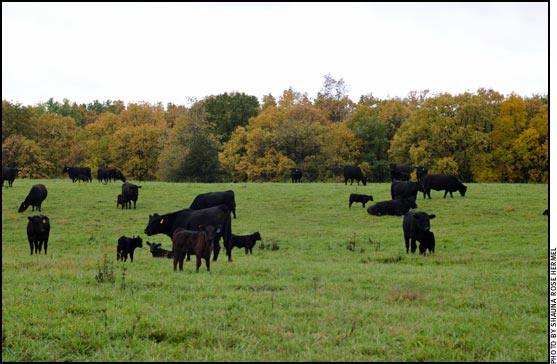Sharing System for Quality Premiums
Quality Beef program can return more dollars, producers learn at
MU Wurdack Farm field day.
Quality beef brings rewards far above the market average, cow herd owners learned at the University of Missouri (MU) Wurdack Farm field day in Crawford County, northeast of Salem, Mo., Oct. 5.
"The current Prime quality-grade premium is $28 per hundredweight," said Mike Kasten, speaking on "Quality Beef by the Numbers." On an 800-pound (lb.) carcass, that adds $224 above market price paid by packing plants.
"That means dollars in your pocket, and they are available now," Kasten added.
Kasten, a beef producer from Bollinger County, became director of the MU Quality Beef (QB) program two months ago. He urges cow herd owners to produce quality.
"Cattle have to work for you, first and foremost, in your forage system," Kasten said. "If you produce quality beef, you can be rewarded for it."
QB grew out of the MU Show-Me-Select (SMS) Replacement Heifer Program. That program taught producers to both manage and add superior genetics to heifers. That added dollar value.
We've been in the program long enough to produce Tier Two heifers, said Kasten, who was first SMS president. Tier Two heifers are sired by highly proven bulls and then bred to SMS-qualified bulls.
"Last year, Tier Two heifers bred AI (artificial insemination) brought $357 more per head than average Show-Me-Select heifers," Kasten said.
"Buyers recognize that heifer quality pays," he added. The QB program aims to do the same with high-quality steers.
Since the start of SMS 15 years ago, more than 101,000 heifers have gone through the program. "That doesn't count heifers from producers who took those same management practices for use in their herds," Kasten said. "The heifer program has made a huge impact on the quality of beef we produce in Missouri."
Kasten cited the example that 10% of all Certified Angus Beef® (CAB®) in the United States can be traced to Missouri.
"With tools and management available to producers, I think we can double that," Kasten said.
The QB program includes the basic management and genetics of SMS, but adds a database and economic tracking of all phases of cattle production from birth to carcass.
Genetic progress in farm herds was hampered by not knowing the value of the final product at the packing plant. Now the QB database at MU will work up the supply chain to assure carcass information comes back.
"Then you must link that carcass data back to a cow and a sire," Kasten said.
Much of the quality in Kasten's herd at Millersville, Mo., comes from using timed AI. That takes labor out of the breeding season.
"I can tell you the day and the hour I will start breeding my cows this fall," he said. "I used to have to get on a horse and bring the cows up twice a day to check for heat. Now I consistently get 65% of the cows bred on the first day of the breeding season. Some are getting 80% bred."
AI is a tool for getting high-quality genetics into cow herds. MU has been a leader in bringing quality genetics to the state, Kasten said. He cited reproduction research by Dave Patterson at MU Thompson Farm, Spickard.
"Now 30% of those cattle sent to the feedyard are grading Prime. The national average for Prime is 3%," Kasten said. "That means more money back to Missouri, and it means good returns from high-end product realized from the forage base of our cow herds.
"We have the ability to select genetics that work in a grass system, in feedyards and in the cooler," he added. "We can have it all. We have data from my cows and from the university herd to back up that statement."
Some people believe the old myth that if you feed a steer long enough, it will grade Prime. "Not if it doesn't have the genetics," Kasten said. "You can feed them until they roll over, and they won't grade Prime. Outside fat is different from marbling."
USDA quality grades measure levels of marbling, the fat within the muscle of the steak.
Expected progeny differences (EPDs) are used to select sires best suited for producing quality beef. "There is real meaning in those numbers," Kasten told producers.
Details on the program are available on the Internet at www.quality-beef.com.
Kasten will speak at MU Extension winter meetings now that Agricultural Experiment Station field days are over. QB is part of the MU College of Agriculture, Food and Natural Resources.












